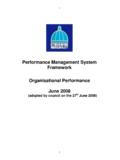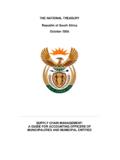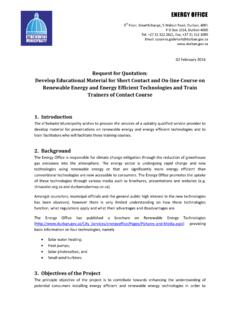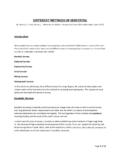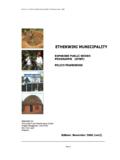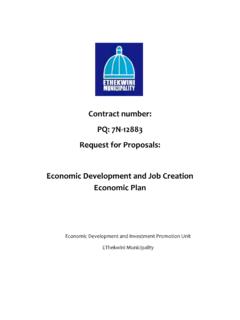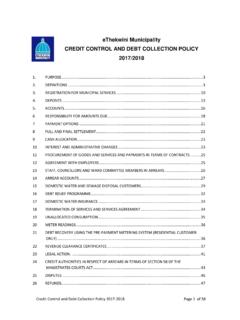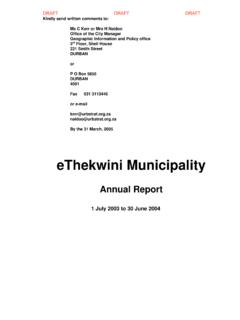Transcription of DURBAN METRO WASTEWATER MANAGEMENT …
1 DURBAN METRO WASTEWATER MANAGEMENT department . POLLUTION DIVISION. GUIDELINES FOR BUILDING PLANS APPROVAL IN RESPECT OF. TRADE EFFLUENT CONTROL AND WATER POLLUTION. PREVENTION IN ORDER TO COMPLY WITH THE DURBAN . METRO SEWAGE DISPOSAL BYLAWS OF FEBRUARY 1999. ENQUIRIES: The guidelines given in this document are intended as a general guideline, for more specific advice please contact:- 3024077 Outer West/Inner West and North Local Council Areas and DURBAN North of the Umgeni River. 3024685 South Local Council and Queensburgh area and DURBAN South of the Umgeni River.
2 January 2002. Guideline/Policy Document No. 11. INDEX. PAGE. 1. Building Plans approval and Compliance with the provisions of the 1. DURBAN METRO Sewage Disposal Bylaws 2. Floor Drainage requirements for Factories and Warehouses where water- 2. borne sewerage is provided 3. Minimum requirements for Floor Drainage and Factories and 3. Warehouses where no water-borne sewerage is provided 4. Trade Effluent Sampling Points 3. 5. Washbay Design and Drainage 3. 6. Storage Areas Design and Drainage 4. 7. Bunding 4. 8. Service Station Drainage 4. 9. Precautionary Stormwater Drainage Pollution Prevention Controls 6.
3 Annexure 1 Sampling Point : Manhole Cover Annexure 2 Medium Sand Oil and Grease Trap Annexure 3 Large Sand Oil and Grease Trap Annexure 4 Modified Open Sand Oil and Grease Trap Annexure 5 Standard Sand Oil and Grease Trap Annexure 6 Washbay Design Annexure 7 Stormwater Pretreatment Trap Annexure 8 Trade Effluent Sampling Point Design Annexure 9 Trade Effluent Application Form -1- GUIDELINES FOR BUILDING PLANS APPROVAL IN RESPECT OF. TRADE EFFLUENT CONTROL AND WATER POLLUTION. PREVENTION IN ORDER TO COMPLY WITH THE DURBAN . METRO SEWAGE DISPOSAL BYLAWS OF MAY 1999.
4 1. BUILDING PLANS APPROVAL AND COMPLIANCE WITH THE PROVISIONS. OF THE DURBAN METRO SEWAGE DISPOSAL BYLAWS. When submitting a building plan an application for permission to discharge trade effluent into the Council sewer must be applied for. A Trade Effluent application form can be seen in Annexure 9 or a copy can be obtained by telephoning the Pollution Division Enquiries on 3024685 or 3024077. For information the relevant Section of the DURBAN METRO Sewage Disposal Bylaws reads as follows:- Section 2/3 : Provision of Services to Trade Premises Any person who wishes to construct or cause to be constructed, a building which shall be used as a trade premises, shall at the time of lodging a building plan in terms of Section 4 of the National Building Regulations and Building Standards Act also lodge applications for connection to the sewage disposal system and for permission to discharge trade effluent in terms of section 4/1 of these bylaws.
5 Additions to Existing Factory : Review of Existing Drainage and Bunding Where additions to an existing factory premises are to be made, a written statement from the developers Professional Engineer or Responsible Person must be obtained, certifying that the bunding and drainage on the premises conforms to National Building regulations and to the relevant SABS regulations and this must be attached to the plan submission. Factories that require additional drainage controls If the factory is to be used for one of the following types of industrial activity or similar then prior consultation with Pollution Division staff on drainage and pre-treatment requirements for inclusion in the drainage plan prior to formal submission is necessary.
6 - Textile Dyeing Metal finishing such as metal plating and anodising Chemical processing and storage Food production Industries using large volumes of water Oil processing and handling Petrol Service Stations -2- Failure to comply with the provisions of the DURBAN METRO Sewage Disposal Bylaw requirements at the time of lodging a building plan could result in unnecessary expense to retrofit drainage requirements for both protection of the Council Sewage Disposal System and protection for preventing pollution of water courses. 2. FLOOR DRAINAGE REQUIREMENTS FOR FACTORIES AND.
7 WAREHOUSES WHERE WATER-BORNE SEWERAGE IS PROVIDED. As a precautionary measure, to prevent pollution of watercourses and public water and in terms of the DURBAN METRO Sewage Disposal Bylaws : Section 6/4 : Installation of Pretreatment Facility, the department requires that factory and warehouse floor areas are drained to the Council foul sewer via a suitably sized pre-treatment trap in order to contain and separate pollutants prior to discharge. Spillages can be contained in this pre- treatment trap (sand, oil and grease trap) in an emergency. The installation of such drainage can be done in various ways.
8 One option is the following:- The floor is levelled and a channel constructed across the entrance within the building in addition thereto, a dished washing area within the building is constructed with a minimum size of 1 x 1 m. Both the channel across the entrance and the dished wash area is connected to an approved sand, oil and grease trap that drains to the Council foul sewer. A water tap must be provided for the dished wash area. Drainage for Mini Factories The floor drainage requirements as set out above also apply to Mini factories with the proviso that the internal wash area must be situated away from the reception area.
9 It is not necessary for each mini factory to have its own sand, oil and grease trap. As a general rule :- One standard sand, oil and grease trap per 10 units - Annexure (5). One medium sand, oil and grease trap per 25 units - Annexure (2). One large sand, oil and grease trap per 75 units - Annexure (3). Washbays for Mini Factories All mini-factories with ten or more units must have a vehicle washbay conforming with the washbay requirements as set out in Section 5. Stormwater Drainage The recommended stormwater pre-treatment trap for mini factories where the risk of stormwater pollution is high, is set out in Annexure (7).
10 3. MINIMUM REQUIREMENTS FOR FLOOR DRAINAGE FOR FACTORIES. AND WAREHOUSES WHERE NO WATER-BORNE SEWERAGE IS. PROVIDED. No trade effluent is permitted to be discharged into a septic tank. The requirements as set out in (1) and (2) above apply with an additional provision of an effluent conservancy tank to accept the discharge of trade effluent from the factory/warehouse wash area. Please note the developer must obtain written permission to discharge the trade effluent -3- from the conservancy tank via a road tanker to a Council facility. 4. TRADE EFFLUENT SAMPLING POINTS.
